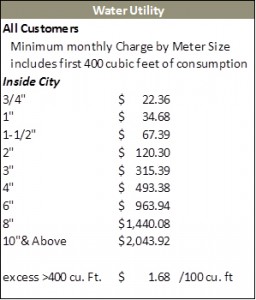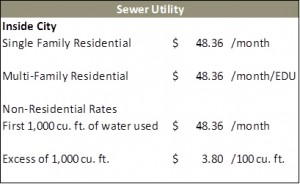In an effort to address community concerns regarding fairness in the utility rate system across customer classes such as residential and commercial, the Bend City Council offers these explanations on the revised water and sewer rate system.
The first workshop on sewer rates will be September 24 from 1 p.m. to 5 p.m. at the Fire Training Center, 63377 Jamison Street in Bend.
Here are the top five things you need to know to understand
1) Why do we have to pay water and sewer rates? I already pay property taxes.
The City of Bend Utilities Department partners with ratepayers to provide vital Water, Wastewater and Stormwater services that help protect customers’ quality of life. These utilities are operated like a business and are fully funded by the fees and charges billed to customers receiving service. No taxes are used to fund utilities.
Sometimes significant infrastructure projects are financed with debt and repaid over time through user rates and charges. The City has periodically increased its utility rates to meet its revenue requirements to provide a high level of service to customers and to meet regulatory requirements. The Utilities use this revenue to maintain system facilities, pay for operational costs such as electricity, chemicals, materials and to improve and expand the system where needed.
2) Why are rates going up in October?
The Bend City Council approved rate increases in June 2014, which take affect October 1, 2014.
Sewer – The Sewer rate increase will support a major upgrade to the Water Reclamation Facility (sewer treatment plant) and a number of improvement projects in the collection system, as well as inflationary increases to operations and maintenance costs. This will result in a $3.99 increase to monthly residential utility bills.
Water – The Water rate increase will support the Bridge Creek Pipeline Replacement and Bridge Creek Water Filtration Plant projects, as well as smaller capital improvement projects and inflationary increases to operations and maintenance costs. This will result in an increase of $1.38 to the average monthly residential utility bill.
3) What does the City currently charge for water and sewer?
The water and sewer rates for in-City customers are provided in the tables below. The rates shown include the aforementioned rate increases of 5 percent for water and 9 percent for sewer. Your actual increase may vary depending on the size of your meter and your water use.
4) How does the City determine how much a customer uses? If you are City of Bend water customer, you are charged a base charge and a volume charge. The base charge, which is based on your meter size, covers the cost of system maintenance, treating and delivering the water, and administrative costs such as billing and customer service. The first 400 cubic feet of your water consumption is included with that fee.
The volume charge depends on the amount of water your household uses as recorded by your water meter. You are charged for each 100 cubic feet (or 748 gallons) above the first 400 cubic feet used in the billing period.
It’s a little different for City of Bend sewer customers. Sewer has two main components: flow and strength (concentration).
Flow: In general, sewer is not metered, so sewer usage is determined by a non-residential customer’s six-month average water usage during the non-irrigation months, to isolate indoor use. Non-residential customers pay a sewer bill for their average water use above 1,000 cubic feet during this period. Residential customers currently pay a flat rate that does not account for individual customers’ usage.
Strength (concentration): The City of Bend designed the sewage treatment system to handle the typical concentration of solids and bacteria that come from a single family home. The City is in the process of implementing a revised “extra strength” program that charges for the concentration component of wastewater coming from non-residential customers that exceeds the average residential concentration. This additional charge is to help pay for extra energy, equipment, chemicals and space necessary to treat the “higher strength” wastewater and to meet regulatory requirements that protect our groundwater.
5) Why is the City revising the water and sewer rate system?
The community has called for more equity in the rate system across customer classes (or categories of customer, such as single-family residential versus multi-family residential versus commercial). In addition, the City Council has requested that the City address affordability more effectively, promote efficient use by connecting bills more directly to system use, and provide revenue and rate stability.
Any revisions to Bend’s water and sewer rate system will be determined this winter. Changes will most likely take place at the beginning of the City’s new fiscal year July 1, 2015.
For more information, visit bendoregon.gov/utilityrates.







